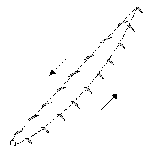Windy Cities
A couple about wind today: Energy Outlook passes on this Wired story about one design for a high-altitude flying windmill. Operated like a kite from a tether, the windmill would be parked in the stratosphere, where wind energy is both constant and large:
 Meantime, terrestrial windpower manufacturers aren't standing still, either. MIT Technology Review writes about advances on land, and General Electric is leading the charge. Already making a 3.6 MW unit with a 104m-diameter rotor, the company plans to make a 7 MW monster with 70m blades.
Meantime, terrestrial windpower manufacturers aren't standing still, either. MIT Technology Review writes about advances on land, and General Electric is leading the charge. Already making a 3.6 MW unit with a 104m-diameter rotor, the company plans to make a 7 MW monster with 70m blades.
At 15,000 feet, winds are strong and constant. On the ground, wind is often unreliable -- the biggest problem for ground-based wind turbines. "For FEGs, the winds are much more persistent than on ground-based machines," said Roberts. "That's part of the benefit, more power and greater concentration."Tests for a prototype Flying Electric Generator -- or FEG -- will likely begin in the Southern California desert after San Diego-based Sky Windpower accumulates the needed capital.
But FEG isn't the first approach to harvesting high-altitude windpower. Wubble Ockels at Delft Technical University has already proposed a "laddermill", a similar scheme, except that energy production occurs on the ground, with airfoils on a continuous belt providing power. Both have the problem that, with moving parts at very high elevations, falling equipment could injure people and damage property beneath.

GE 3.6 MW turbine
“The economics work better as the turbines get bigger—and the name of the game is economics,” says Bob Thresher, director of the National Wind Technology Center, a federal lab in Boulder, CO. The goal of industry and federal researchers is to create wind farms that produce electricity for about three cents per kilowatt-hour, down from about 4.5 cents today; that would beat the cost of fuel for the most efficient new gas-fired power plants—currently about 3.5 cents per kilowatt-hour. If the development process goes well, Thresher says, these huge turbines should be ready for widespread wind farm use in 2012.In case you missed it, the Engineer-Poet ran a nice set of calculations about the utility of wind power. It may not be as schedulable as conventional gas power plants, but it doesn't generate greenhouse gases, either.




<< Home